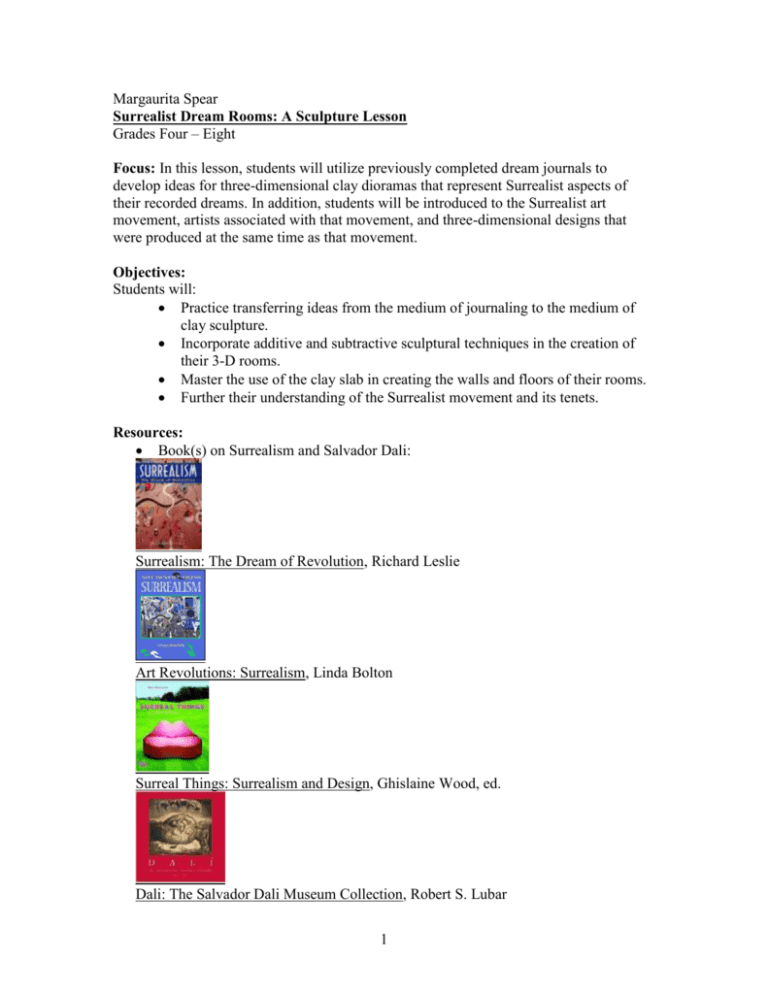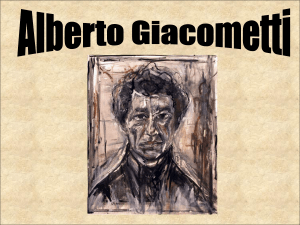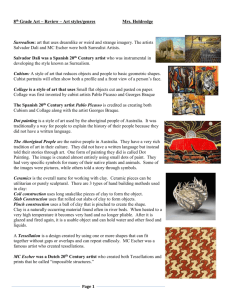Surrealist Dream Rooms: A Sculpture Lesson
advertisement

Margaurita Spear Surrealist Dream Rooms: A Sculpture Lesson Grades Four – Eight Focus: In this lesson, students will utilize previously completed dream journals to develop ideas for three-dimensional clay dioramas that represent Surrealist aspects of their recorded dreams. In addition, students will be introduced to the Surrealist art movement, artists associated with that movement, and three-dimensional designs that were produced at the same time as that movement. Objectives: Students will: Practice transferring ideas from the medium of journaling to the medium of clay sculpture. Incorporate additive and subtractive sculptural techniques in the creation of their 3-D rooms. Master the use of the clay slab in creating the walls and floors of their rooms. Further their understanding of the Surrealist movement and its tenets. Resources: Book(s) on Surrealism and Salvador Dali: Surrealism: The Dream of Revolution, Richard Leslie Art Revolutions: Surrealism, Linda Bolton Surreal Things: Surrealism and Design, Ghislaine Wood, ed. Dali: The Salvador Dali Museum Collection, Robert S. Lubar 1 Resources (continued): Images of surrealist objects: Table with Bird’s Legs, Meret Oppenheim 1939 Mae West Lips Sofa, Salvador Dali and Edward James 1938 Mae West’s Face which May Be Used as a Surrealist Apartment, Salvador Dali 1934-5 Examples of completed projects Vocabulary: Surrealism: An art movement founded in Paris in 1924 that was concerned with irrational elements in art, was preoccupied with Freudian psychoanalysis, and aimed to create art that was a direct result of the unconscious mind. Diorama: A three-dimensional representation of a scene; usually represented as a three-walled room with no ceiling. Slab: A flat piece of clay, resembling a tile, usually formed either through us of a rolling pin and depth guides or through the method of “throwing a slab.” Additive: The process of adding material to create a desired form. Subtractive: The process of removing material to achieve a desired form. Distortion: A twisting of a shape or form into something different than its normal appearance. Time: This assignment will take approximately five fifty-minute class sessions. Materials: Kiln-fire clay Clay carving tools Clay slip Container for slip Glazes 2 Brushes Canvas mats Rolling pins Depth guides (squared sticks, about ¼” deep) Materials (continued): Rulers Alternate Materials: Air-dry clay Clay carving tools Acrylic paints Acrylic gloss medium Brushes Containers for water Paper towels Rolling pins Depth guides (squared sticks, about ¼” deep) Rulers Paper towels Preparation: Center area for supplies to be obtained and returned Prepare batch of clay slip in advance Introduction: Surrealist artists created works that showed a strong influence of dream imagery, which could often be deemed both real and bizarre at the same time. After the movement swept across the continents, Surrealism was apparent in both two-dimensional and threedimensional forms; often artists like Salvador Dali created works in both realms. Surrealism influenced elements of design, fashion, and commercialism as well as fine art. Dali’s foray into commercialism with the Mae West Lips sofa, which appeared in an ad for an apartment resembling Mae West’s face, followed the development of anthropomorphic furniture. Meret Oppenheim also created two Surrealist objects, including the design for a table with bird legs. Instruction: This lesson will feature activities that promote a three-dimensional foray into the concept of Surrealism and introduce the idea of the dream place, in this case a room in which dream-like objects exist in a surreal reality. 1. The students will begin by discussing images of Surrealist objects, paying careful attention to how seemingly unrelated objects are merged together to create unified forms. The discussion should then turn to their dream journals. The students may be led to answer such questions as: What types of objects appeared in your own dreams? Did they always look real or were they strange in some way? What environment were they found in? In rooms? Outdoors? How could you exaggerate some of your dream imagery to create works of art that have more Surrealist characteristics? 2. Following the discussion on Surrealist objects and dream imagery, demonstrate the materials that will be used to create three-dimensional rooms (or dioramas of their dreams). The partial boxes for the rooms, as well as the objects contained in them, will be created from clay using a variety of additive and subtractive handbuilding techniques. 3. To begin, the boxes will be made from three wall slabs and one floor slab. A slab can be formed two ways. One is to throw the slab; however, this requires a great 3 Instruction (continued): deal of experience and skill. The other is to roll out the clay, using depth guides to ensure an even depth throughout the clay piece. 4. Prepare the clay by wedging (kneading) it to a workable consistency. Tap the clay into a cube shape to remove internal air bubbles that can cause problems during the firing of an assembled piece. 5. Flatten out the first slab piece by slapping it onto the working surface (a piece of canvas makes for a good work surface). After it has been slapped a few times, place a depth guide on each side of the clay and use a rolling pin to flatten out the piece. The distance between the two guides will be the width of the slab. If the desired diorama is a cube, use a ruler to make sure that each slab is cut to the same measurements. 6. Demonstrate joining the slabs, using slip and score techniques. Score each joining edge with a knife or toothpick. Wet with some prepared slip and carefully press together, smoothing the seams. Explain that the use of scoring and slipping is important during kiln firing when the clay undergoes a molecular change. Molecules pass between the two pieces of clay joining them to each other. The interior joints of the boxes can be reinforced by applying a snake-like piece of clay along the interior seams and smoothing it into the side walls. 7. Demonstrate other hand-building techniques that may be used when making the objects, like forming a round object by starting with a pinch pot approach, hollowing out a form, rolling out a coil, or joining pieces of clay together to create objects. 8. For the objects that will occupy the dream rooms, students must decide if they will be permanently placed or repositionable. If permanently placed, each object will need to be scored and slipped to be attached. If movable, they can be fired separately from the boxes. 9. After the clay demonstration, give students small pieces of clay to experiment with. This clay will be discarded at the end of the first class session, so students should be told that anything they create should not be thought of as precious. They should practice making slabs and other forms with the clay to get used to the material. 10. On the second day, the goal is for the students to complete the four slabs needed to form their rooms (three walls and a floor). Review joining techniques if needed. At the end of the second class session, the students should have made their slabs and joined them to create rooms. Spray the clay rooms with water and wrap them in plastic to prevent the clay from drying out. 11. On the third and fourth day, the goal is for the students to furnish their rooms. Review any hand-building techniques that the students may have forgotten. Encourage discussion of the surrealist objects as they are being created. Frequently walk around the room and engage students in conversations about their dream rooms. Remember, finished pieces should be hollowed out to a ¼” thickness to prevent explosions during firing. 12. Loosely wrap the finished clay rooms in plastic, allowing some air to circulate around the sculptures. As the pieces show evidence of drying, remove the plastic 4 Instruction (continued): and allow them to dry to a bone dry state. The clay will change color and the surface quality will change as the moisture in the clay evaporates. 13. Once bone dry, bisque fire the clay in the kiln following manufacturer’s instructions. 14. On the last day of classroom instruction after the pieces have been bisque fired, the students should be given a selection of ceramic glazes to color their pieces to better reflect their dream imagery. Explain the process of glazing. Glaze colors come out of the kiln looking different than they do when applied. Have fired samples available so students know what the resulting colors will be. Caution against applying glaze close to the bottoms of pieces. The glaze will run during firing and if glazed too close to the bottoms the pieces could fuse to the kiln’s shelves, damaging the pieces and the shelves. 15. Fire the glazed pieces one last time following manufacturer’s instructions. *Alternate materials: If using air-dry clay, follow the manufacturer’s instructions for joining pieces together. Allow to air-dry completely. Substitute glazes with acrylic paints. You may opt to use acrylic gloss medium after the painted pieces dry to achieve a shiny surface similar to glazed pottery. Teacher Evaluation: 1. Were students able to incorporate their own dream imagery into their finished sculptures? 2. Were students successful in using hand-building techniques, including the joining of slabs and the hollowing of forms? 3. Did students demonstrate an understanding of Surrealist objects through the exaggeration of their own forms and the inclusion of seemingly unrelated elements? Massachusetts Arts Curriculum Framework Standards: In this lesson, students will work with the following standards: *Standard 1: Methods Material and Techniques 1.1 Use a variety of materials and media. 1.2 Create artwork in a variety of two-dimensional and three-dimensional media. 1.3 Learn and use appropriate vocabulary related to the methods, materials, and techniques. 1.4 Learn to take care of materials and tools and use them safely. *Standard 2: Elements and Principles of Design 2.4 For shape and form, explore the use of shapes and forms in 2D and 3D works. *Standard 3: Observation, Abstraction, Invention, and Expression 3.3 Create 2D and 3D artwork from memory of imagination to tell a story of embody and idea or fantasy. 3.5 Create symbolic artwork by substituting symbols for objects, relationships, or ideas. 3.6 Create artwork that employs the use of free form symbolic imagery that demonstrates personal invention, and/or conveys ideas and emotions. 5 Massachusetts Arts Curriculum Framework Standards (continued): *Standard 4: Drafting, Revising, and Exhibiting 4.4 Produce work that shows and understanding of the concept of craftsmanship. *Standard 5: Critical Response 5.6 Demonstrate the ability to describe the kinds of imagery used to represent subject matter and ideas, for example, literal representation, simplification, abstraction, or symbolism. *Standard 8: Concepts of Style, Stylistic Influence, and Stylistic Change 8.3 Perform or create works inspired by historical or cultural styles. 6 Surrealist Dream Rooms Lesson Rubric **Excellent** 20 points Media and Techniques Slab formation and assembly **Good** 15 points **Fair** 10 points **Poor** 5 points Slabs are either too thick to too thin, are not measured out in any way and are joined with no consideration. They may have many cracks or may not have stayed together during firing. There is no evidence of a correlation between the dream journal and the objects in the dream room. No objects in the dream room were carefully formed, hollowed out or joined. Slabs are of correct depth, carefully measured and joined. No cracks or breaks are present. Slabs are mostly the correct depth, measured out and carefully joined. Only a few cracks may be present. Slabs are mostly the correct depth, possibly eyeballed rather than measured out and joined with some consideration. Several cracks may be present. Incorporation of recorded dreams from journals There is an abundance of evidence of a correlation between the dream journal and the objects in the dream room. There is some evidence of a correlation between the dream journal and the objects in the dream room. Hand-building craftsmanship All objects in the dream room were carefully formed, hollowed out and joined. Most objects in the dream room were carefully formed, hollowed out and joined. There is minimal evidence of a correlation between the dream journal and the objects in the dream room. Few objects in the dream room were carefully formed, hollowed out and joined. Glazing Glazes were applied with precision and care. Attention given to the colors used. Glazes were applied with some precision and care. Some attention given to the colors used. Glazes were applied with minimal precision and care. Minimal attention given to the colors used. Many objects in the dream room show the use of exaggeration or merged forms to imply an understanding of Surrealist objects. Several objects in the dream room show the use of exaggeration or merged forms to imply an understanding of Surrealist objects. Few objects in the dream room show the use of exaggeration or merged forms to imply an understanding of Surrealist objects. Understanding of Surrealist objects 7 Glazes were applied with no precision or care. Some of the glaze may have dripped onto the kiln shelves during firing, possibly damaging the piece. No attention given to the colors used. No objects in the dream room show the use of exaggeration or merged forms to imply an understanding of Surrealist objects. *Comments*







